Quan Yuan
VICTOR: Dataset Copyright Auditing in Video Recognition Systems
Dec 16, 2025Abstract:Video recognition systems are increasingly being deployed in daily life, such as content recommendation and security monitoring. To enhance video recognition development, many institutions have released high-quality public datasets with open-source licenses for training advanced models. At the same time, these datasets are also susceptible to misuse and infringement. Dataset copyright auditing is an effective solution to identify such unauthorized use. However, existing dataset copyright solutions primarily focus on the image domain; the complex nature of video data leaves dataset copyright auditing in the video domain unexplored. Specifically, video data introduces an additional temporal dimension, which poses significant challenges to the effectiveness and stealthiness of existing methods. In this paper, we propose VICTOR, the first dataset copyright auditing approach for video recognition systems. We develop a general and stealthy sample modification strategy that enhances the output discrepancy of the target model. By modifying only a small proportion of samples (e.g., 1%), VICTOR amplifies the impact of published modified samples on the prediction behavior of the target models. Then, the difference in the model's behavior for published modified and unpublished original samples can serve as a key basis for dataset auditing. Extensive experiments on multiple models and datasets highlight the superiority of VICTOR. Finally, we show that VICTOR is robust in the presence of several perturbation mechanisms to the training videos or the target models.
Geometric Parameter Optimization of a Novel 3-(PP(2-(UPS))) Redundant Parallel Mechanism based on Workspace Determination
Dec 16, 2025Abstract:Redundant parallel robots are normally employed in scenarios requiring good precision, high load capability, and large workspace compared to traditional parallel mechanisms. However, the elementary robotic configuration and geometric parameter optimization are still quite challenging. This paper proposes a novel 3-(PP(2-(UPS))) redundant parallel mechanism, with good generalizability first, and further investigates the kinematic optimization issue by analyzing and investigating how its key geometric parameters influence the volume, shape, boundary completeness, and orientation capabilities of its workspace. The torsional capability index TI_1 and tilting capability index TI_2 are defined to evaluate the orientation performance of the mechanism. Numerical simulation studies are completed to indicate the analysis, providing reasonable but essential references for the parameter optimization of 3-(PP(2-(UPS))) and other similar redundant parallel mechanisms.
Design and Validation of an Under-actuated Robotic Finger with Synchronous Tendon Routing
Dec 11, 2025Abstract:Tendon-driven under-actuated robotic fingers provide advantages for dexterous manipulation through reduced actuator requirements and simplified mechanical design. However, achieving both high load capacity and adaptive compliance in a compact form remains challenging. This paper presents an under-actuated tendon-driven robotic finger (UTRF) featuring a synchronous tendon routing that mechanically couples all joints with fixed angular velocity ratios, enabling the entire finger to be actuated by a single actuator. This approach significantly reduces the number of actuators required in multi-finger hands, resulting in a lighter and more compact structure without sacrificing stiffness or compliance. The kinematic and static models of the finger are derived, incorporating tendon elasticity to predict structural stiffness. A single-finger prototype was fabricated and tested under static loading, showing an average deflection prediction error of 1.0 mm (0.322% of total finger length) and a measured stiffness of 1.2x10^3 N/m under a 3 kg tip load. Integration into a five-finger robotic hand (UTRF-RoboHand) demonstrates effective object manipulation across diverse scenarios, confirming that the proposed routing achieves predictable stiffness and reliable grasping performance with a minimal actuator count.
NegoCollab: A Common Representation Negotiation Approach for Heterogeneous Collaborative Perception
Oct 31, 2025Abstract:Collaborative perception improves task performance by expanding the perception range through information sharing among agents. . Immutable heterogeneity poses a significant challenge in collaborative perception, as participating agents may employ different and fixed perception models. This leads to domain gaps in the intermediate features shared among agents, consequently degrading collaborative performance. Aligning the features of all agents to a common representation can eliminate domain gaps with low training cost. However, in existing methods, the common representation is designated as the representation of a specific agent, making it difficult for agents with significant domain discrepancies from this specific agent to achieve proper alignment. This paper proposes NegoCollab, a heterogeneous collaboration method based on the negotiated common representation. It introduces a negotiator during training to derive the common representation from the local representations of each modality's agent, effectively reducing the inherent domain gap with the various local representations. In NegoCollab, the mutual transformation of features between the local representation space and the common representation space is achieved by a pair of sender and receiver. To better align local representations to the common representation containing multimodal information, we introduce structural alignment loss and pragmatic alignment loss in addition to the distribution alignment loss to supervise the training. This enables the knowledge in the common representation to be fully distilled into the sender.
Beyond BEV: Optimizing Point-Level Tokens for Collaborative Perception
Aug 27, 2025Abstract:Collaborative perception allows agents to enhance their perceptual capabilities by exchanging intermediate features. Existing methods typically organize these intermediate features as 2D bird's-eye-view (BEV) representations, which discard critical fine-grained 3D structural cues essential for accurate object recognition and localization. To this end, we first introduce point-level tokens as intermediate representations for collaborative perception. However, point-cloud data are inherently unordered, massive, and position-sensitive, making it challenging to produce compact and aligned point-level token sequences that preserve detailed structural information. Therefore, we present CoPLOT, a novel Collaborative perception framework that utilizes Point-Level Optimized Tokens. It incorporates a point-native processing pipeline, including token reordering, sequence modeling, and multi-agent spatial alignment. A semantic-aware token reordering module generates adaptive 1D reorderings by leveraging scene-level and token-level semantic information. A frequency-enhanced state space model captures long-range sequence dependencies across both spatial and spectral domains, improving the differentiation between foreground tokens and background clutter. Lastly, a neighbor-to-ego alignment module applies a closed-loop process, combining global agent-level correction with local token-level refinement to mitigate localization noise. Extensive experiments on both simulated and real-world datasets show that CoPLOT outperforms state-of-the-art models, with even lower communication and computation overhead. Code will be available at https://github.com/CheeryLeeyy/CoPLOT.
Strongly Consistent Community Detection in Popularity Adjusted Block Models
Jun 08, 2025Abstract:The Popularity Adjusted Block Model (PABM) provides a flexible framework for community detection in network data by allowing heterogeneous node popularity across communities. However, this flexibility increases model complexity and raises key unresolved challenges, particularly in effectively adapting spectral clustering techniques and efficiently achieving strong consistency in label recovery. To address these challenges, we first propose the Thresholded Cosine Spectral Clustering (TCSC) algorithm and establish its weak consistency under the PABM. We then introduce the one-step Refined TCSC algorithm and prove that it achieves strong consistency under the PABM, correctly recovering all community labels with high probability. We further show that the two-step Refined TCSC accelerates clustering error convergence, especially with small sample sizes. Additionally, we propose a data-driven approach for selecting the number of communities, which outperforms existing methods under the PABM. The effectiveness and robustness of our methods are validated through extensive simulations and real-world applications.
Probing In-Context Learning: Impact of Task Complexity and Model Architecture on Generalization and Efficiency
May 10, 2025Abstract:We investigate in-context learning (ICL) through a meticulous experimental framework that systematically varies task complexity and model architecture. Extending beyond the linear regression baseline, we introduce Gaussian kernel regression and nonlinear dynamical system tasks, which emphasize temporal and recursive reasoning. We evaluate four distinct models: a GPT2-style Transformer, a Transformer with FlashAttention mechanism, a convolutional Hyena-based model, and the Mamba state-space model. Each model is trained from scratch on synthetic datasets and assessed for generalization during testing. Our findings highlight that model architecture significantly shapes ICL performance. The standard Transformer demonstrates robust performance across diverse tasks, while Mamba excels in temporally structured dynamics. Hyena effectively captures long-range dependencies but shows higher variance early in training, and FlashAttention offers computational efficiency but is more sensitive in low-data regimes. Further analysis uncovers locality-induced shortcuts in Gaussian kernel tasks, enhanced nonlinear separability through input range scaling, and the critical role of curriculum learning in mastering high-dimensional tasks.
Individual Bus Trip Chain Prediction and Pattern Identification Considering Similarities
Dec 16, 2024Abstract:Predicting future bus trip chains for an existing user is of great significance for operators of public transit systems. Existing methods always treat this task as a time-series prediction problem, but the 1-dimensional time series structure cannot express the complex relationship between trips. To better capture the inherent patterns in bus travel behavior, this paper proposes a novel approach that synthesizes future bus trip chains based on those from similar days. Key similarity patterns are defined and tested using real-world data, and a similarity function is then developed to capture these patterns. Afterwards, a graph is constructed where each day is represented as a node and edge weight reflects the similarity between days. Besides, the trips on a given day can be regarded as labels for each node, transferring the bus trip chain prediction problem to a semi-supervised classification problem on a graph. To address this, we propose several methods and validate them on a real-world dataset of 10000 bus users, achieving state-of-the-art prediction results. Analyzing the parameters of similarity function reveals some interesting bus usage patterns, allowing us can to cluster bus users into three types: repeat-dominated, evolve-dominate and repeat-evolve balanced. In summary, our work demonstrates the effectiveness of similarity-based prediction for bus trip chains and provides a new perspective for analyzing individual bus travel patterns. The code for our prediction model is publicly available.
Predicting Subway Passenger Flows under Incident Situation with Causality
Dec 09, 2024
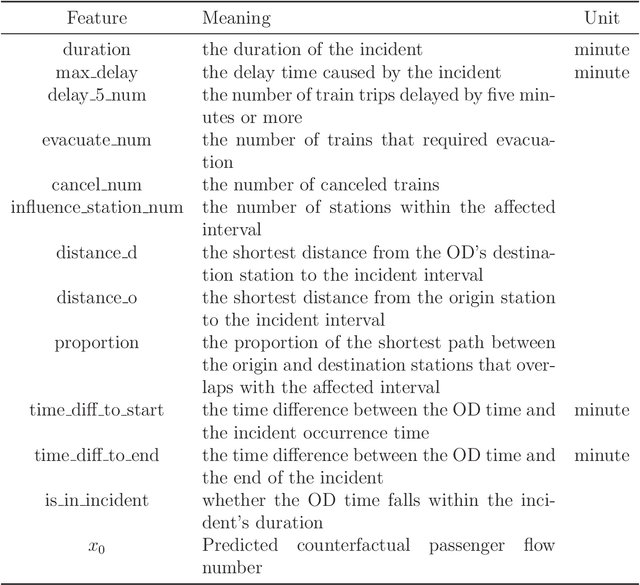
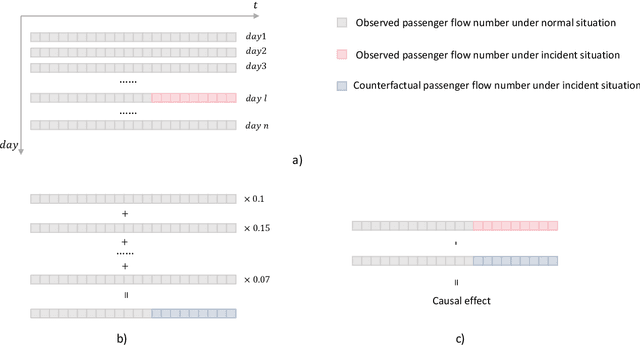
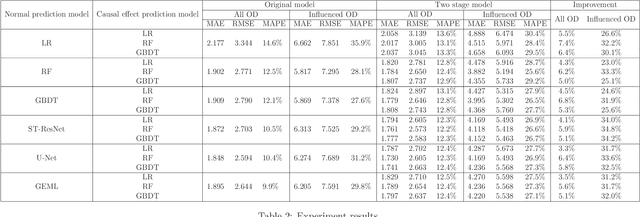
Abstract:In the context of rail transit operations, real-time passenger flow prediction is essential; however, most models primarily focus on normal conditions, with limited research addressing incident situations. There are several intrinsic challenges associated with prediction during incidents, such as a lack of interpretability and data scarcity. To address these challenges, we propose a two-stage method that separates predictions under normal conditions and the causal effects of incidents. First, a normal prediction model is trained using data from normal situations. Next, the synthetic control method is employed to identify the causal effects of incidents, combined with placebo tests to determine significant levels of these effects. The significant effects are then utilized to train a causal effect prediction model, which can forecast the impact of incidents based on features of the incidents and passenger flows. During the prediction phase, the results from both the normal situation model and the causal effect prediction model are integrated to generate final passenger flow predictions during incidents. Our approach is validated using real-world data, demonstrating improved accuracy. Furthermore, the two-stage methodology enhances interpretability. By analyzing the causal effect prediction model, we can identify key influencing factors related to the effects of incidents and gain insights into their underlying mechanisms. Our work can assist subway system managers in estimating passenger flow affected by incidents and enable them to take proactive measures. Additionally, it can deepen researchers' understanding of the impact of incidents on subway passenger flows.
Multiscale spatiotemporal heterogeneity analysis of bike-sharing system's self-loop phenomenon: Evidence from Shanghai
Nov 26, 2024
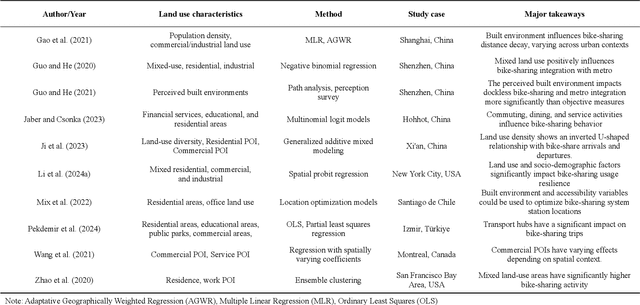
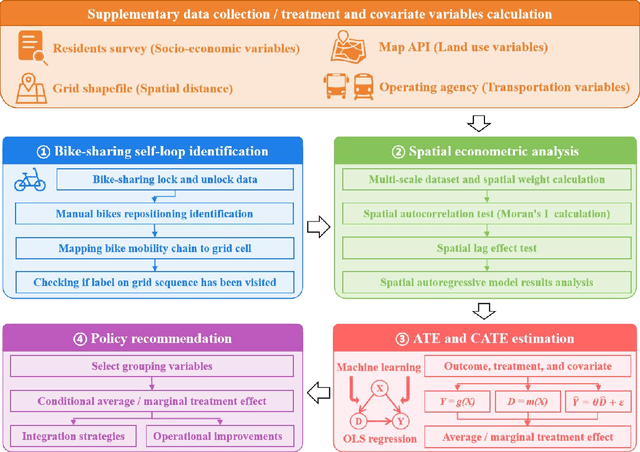
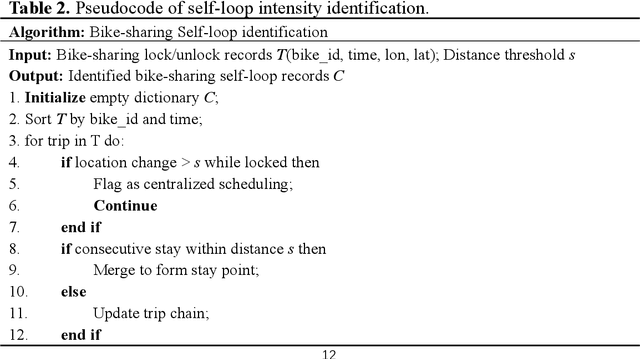
Abstract:Bike-sharing is an environmentally friendly shared mobility mode, but its self-loop phenomenon, where bikes are returned to the same station after several time usage, significantly impacts equity in accessing its services. Therefore, this study conducts a multiscale analysis with a spatial autoregressive model and double machine learning framework to assess socioeconomic features and geospatial location's impact on the self-loop phenomenon at metro stations and street scales. The results reveal that bike-sharing self-loop intensity exhibits significant spatial lag effect at street scale and is positively associated with residential land use. Marginal treatment effects of residential land use is higher on streets with middle-aged residents, high fixed employment, and low car ownership. The multimodal public transit condition reveals significant positive marginal treatment effects at both scales. To enhance bike-sharing cooperation, we advocate augmenting bicycle availability in areas with high metro usage and low bus coverage, alongside implementing adaptable redistribution strategies.
 Add to Chrome
Add to Chrome Add to Firefox
Add to Firefox Add to Edge
Add to Edge